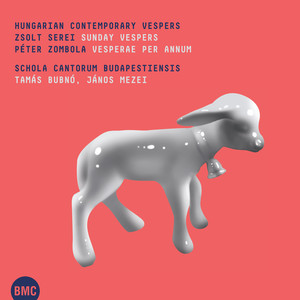
Hungarian Contemporary Vespers
- 歌唱: János Mezei/ Tamás Bubnó/ Schola Cantorum Budapestiensis
- 发行时间:2015-05-22
- 唱片公司:BMC Records
- 唱片编号:BMC CD 211
- 类型:录音室专辑
- 歌曲
- 时长
-
作曲家:Zsolt Serei
-
作品集:Sunday Vespers
-
作曲家:Péter Zombola
-
作品集:Vesperae Per Annum
简介
Singing together the Evening Offi e – the Vespers – was a part of the celebration of the feastdays for the priests and for their congregations ever since the early centuries of Christianity. This practice survived until the end of the Middle Ages, and in certain regions of Europe, such as Transylvania, even up to recent times. After the invention of polyphony, parts of the chants for the Vespers were replaced by polyphonic transcriptions performed by soloists. These pieces were, naturally, conceived in the musical language of the respective period. The heyday of this compositional practice came with the “concert-Vespers” of Viennese classicism (for example the Vespers of W. A. Mozart). Later this practice was abandoned, yet the possibility of enriching the recitative style of the ancient Gregorian chants with movements composed in the musical language of the present still exists. Two Hungarian composers representing two modern generations, Zsolt Serei and Péter Zombola, reached back to this tradition and composed two Vespers cycles. These full cycles were not meant to be performed on one occasion; rather, we encourage ambitious choirs and congregations to select some pieces from them for one liturgical occasion, and insert them into the Liturgy in the way clausulae were inserted in the 12th–13th century Notre Dame organum practice. Works of real artistic value deserve to become part of the daily celebrated liturgy. (János Mezei) I have known Tamás Bubnó and János Mezei, the leaders of the Schola Cantorum Budapestiensis, since I was a youngster. I knew about the founding of their special school, and I knew how strongly they were attached to the singing of the mass and the offices. So I was prepared to meet their request to compose choral pieces for the per annum Vespers. It was an interesting task to compose pieces of different lengths and characters and adjust them to the dominant musical environment of Gregorian chant. Becoming familiar with this incredibly rich and nuanced musical culture gave me the impulse to compose melodies in the Gregorian style. On the other hand this task was similar to any other compositional task: I had to use the possibilities given by a text and a structure, and to shape them, to incorporate them into a unique sonic reality. The question still remains, whether the essential musical message of these works can be perceived by those who live with this music as performers or listeners. (Zsolt Serei) I first came into contact with the Schola Cantorum Budapestiensis and its leaders, Tamás Bubnó and János Mezei when I started my studies at the Liszt Academy of Music. I attended their services at church and the concerts they organized, and it was not long before I had the idea of composing choral pieces for liturgical use. The choir movement initiated by Kodály and Bárdos promoted a certain kind of musical language, and did not rouse my interest. But the sound of Gregorian chant attracted me to vocal genres, and still retains my fascination. At the beginning I made a few random trials, but after a while I decided to compose a larger, more complex work. This is how the idea of composing a whole Vespers cycle came. I worked on the piece for three years, and the premiere was conducted by György Philipp in 2006, after which a recording soon followed. The Vespers proved to be the starting point for all my larger sacred works composed since then (Missa sine nomine, Requiem, Passio) so it has exerted a decisive influence on my oeuvre over the past ten years. (Péter Zombola)

